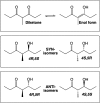Olfactory Receptor Neurons for Plant Volatiles and Pheromone Compounds in the Lucerne Weevil, Sitona discoideus
- PMID: 32048118
- PMCID: PMC7142041
- DOI: 10.1007/s10886-020-01160-y
Olfactory Receptor Neurons for Plant Volatiles and Pheromone Compounds in the Lucerne Weevil, Sitona discoideus
Abstract
Antennal olfactory receptor neurons (ORNs) for pheromone-related and plant volatile compounds were identified and characterized in the lucerne weevil, Sitona discoideus (Gyllenhal), using the single sensillum recording technique. Our study using five pheromone-related compounds and 42 plant volatile compounds indicates that S. discoideus have highly specialized ORNs for pheromone and plant volatile compounds. Different groups of ORNs present in both males and females of S. discoideus were highly sensitive to 4-methylheptane-3,5-dione (diketone) and four isomers (RR, RS, SR and SS) of 5-hydroxy-4-methylheptan-3-one, respectively. Our results also indicate that male S. discoideus, using the sensory input from antennal ORNs, can distinguish both diketone and the RR-isomer from others, and RS- and SS-isomers from others, although it was unclear if they can distinguish between RS-isomer and SS-isomer, or between diketone and the SR-isomer. It also appeared that female S. discoideus could distinguish between RS-isomer and SS-isomers. The antennae of S. discoideus thus contain sex-specific sets of ORNs for host- and non-host plant volatile compounds. Both sexes of S. discoideus have highly sensitive and selective ORNs for some green-leaf volatiles, such as (Z)-3-hexenol and (E)-2-hexenal. In contrast, male antennae of S. discoideus house three distinct groups of ORNs specialized for myrcene and (E)-β-ocimene, 2-phenylethanol, and phenylacetaldehyde, respectively, whereas female antennae contain three groups of ORNs specialized for (±)-linalool and (±)-α-terpineol, myrcene and (E)-β-ocimene, (±)-1-octen-3-ol, and 3-octanone. Our results suggest that S. discoideus use a multi-component pheromone communication system, and a sex-specific set of ORNs with a narrow range of response spectra for host-plant location.
Keywords: 4-methyl-3,5- heptanedione; 5-hydroxy-4-methyl-3-heptanone; Host-plant volatiles; Olfactory sensilla; Pheromone; Single-sensillum recording.
Figures







Similar articles
-
Characterization of olfactory receptor neurons for pheromone candidate and plant volatile compounds in the clover root weevil, Sitona lepidus.J Insect Physiol. 2013 Dec;59(12):1222-34. doi: 10.1016/j.jinsphys.2013.10.002. Epub 2013 Oct 23. J Insect Physiol. 2013. PMID: 24161831
-
Identification and electrophysiological studies of (4S,5S)-5-hydroxy-4-methyl-3-heptanone and 4-methyl-3,5-heptanedione in male lucerne weevils.Naturwissenschaften. 2013 Feb;100(2):135-43. doi: 10.1007/s00114-012-1003-4. Epub 2012 Dec 13. Naturwissenschaften. 2013. PMID: 23238636
-
Interference of plant volatiles on pheromone receptor neurons of male Grapholita molesta (Lepidoptera: Tortricidae).J Insect Physiol. 2015 Oct;81:118-28. doi: 10.1016/j.jinsphys.2015.07.009. Epub 2015 Jul 16. J Insect Physiol. 2015. PMID: 26188269
-
Working range of stimulus flux transduction determines dendrite size and relative number of pheromone component receptor neurons in moths.Chem Senses. 2012 May;37(4):299-313. doi: 10.1093/chemse/bjr122. Epub 2012 Jan 9. Chem Senses. 2012. PMID: 22230170 Review.
-
A meta-analytic investigation of the potential for plant volatiles and sex pheromones to enhance detection and management of Lepidopteran pests.Bull Entomol Res. 2023 Dec;113(6):725-734. doi: 10.1017/S0007485323000457. Epub 2023 Oct 19. Bull Entomol Res. 2023. PMID: 37855152 Review.
Cited by
-
Anti-inflammatory and Anti-proliferative Role of Essential Oil of Leaves of Cleistocalyx operculatus (Roxb.) Merr. & Perry.Anticancer Agents Med Chem. 2025;25(4):232-243. doi: 10.2174/0118715206304193240715043704. Anticancer Agents Med Chem. 2025. PMID: 39568110
-
Aggregation Pheromones of Weevils (Coleoptera: Curculionidae): Advances in the Identification and Potential Uses in Semiochemical-Based Pest Management Strategies.J Chem Ecol. 2021 Dec;47(12):968-986. doi: 10.1007/s10886-021-01319-1. Epub 2021 Oct 21. J Chem Ecol. 2021. PMID: 34671912 Review.
References
-
- Aeschlimann JP. Sampling methods and construction of life tables for Sitona humeralis Stephens (Col., Curculionidae) in Mediterranean climatic areas. J Appl Ecol. 1979;16:405–415. doi: 10.2307/2402518. - DOI
-
- Baker TC, Fadamiro HY, Cossé AA. Moths uses fine tuning for odour resolution. Nature. 1998;393:530. doi: 10.1038/31131. - DOI
-
- Barratt BIP, Barker GM, Addison PJ. Sitona lepidus Gyllenhal (Coleoptera: Curculionidae), a potential clover pest new to New Zealand. N Z Entomol. 1996;19:23–30. doi: 10.1080/00779962.1996.9722017. - DOI
-
- Blight MM, Dawson GW, Pickett JA, Wadhams LJ. The identification and biological activity of the aggregation pheromone of Sitona lineatus. Asp Appl Biol. 1991;27:137–142.
-
- Blight MM, Pickett JA, Smith MC, Wadhams LJ. An aggregation pheromone of Sitona lineatus. Naturwissenschaften. 1984;71:480. doi: 10.1007/BF00455905. - DOI
MeSH terms
Substances
Grants and funding
LinkOut - more resources
Full Text Sources
Research Materials

